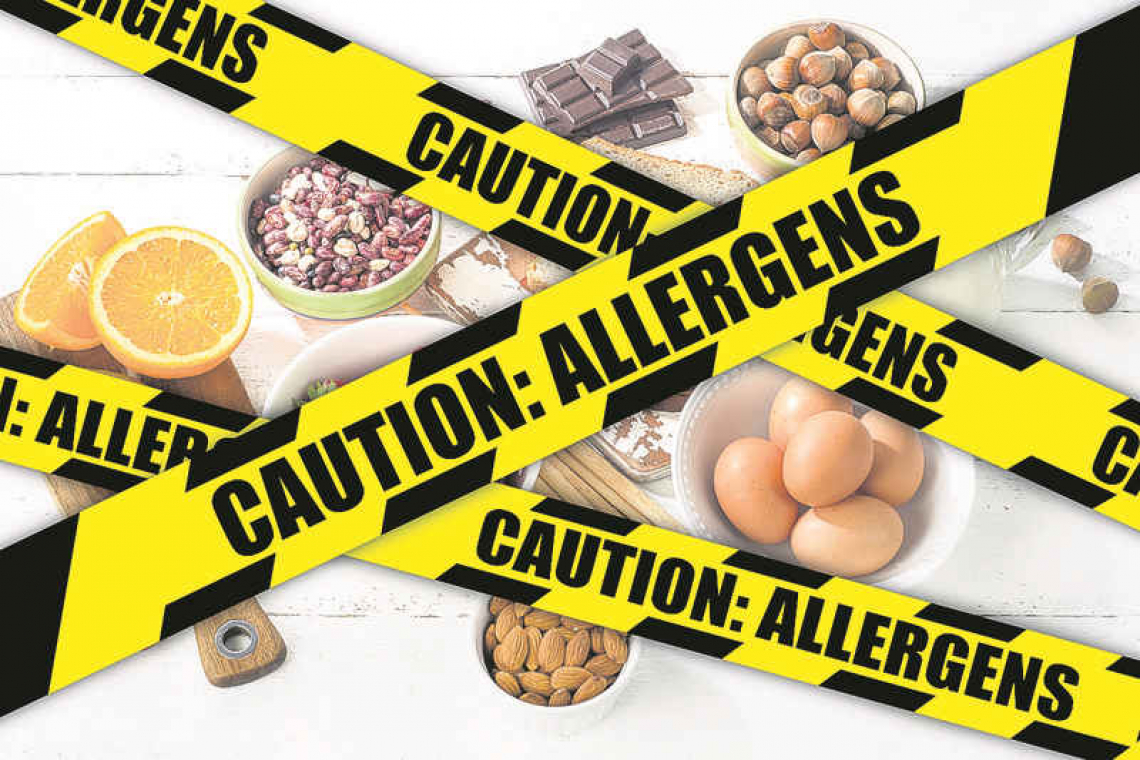Author: Colin Michie
Catering for tourists on Caribbean islands, cruise ships or even long-haul aircraft has never been easy. Advertisements inevitably tempt with varieties of cocktails, sea-foods and tropical fruit in colourful profusion. Much planning lies behind beach-bar menus and snacks, hotel feasts and restaurant specials.
What materials have been used to create St. Martin’s culinary treasures, her secret sauces? Do they contain peanuts, kiwi fruit, milk, egg, prawns or sesame seeds – even as traces? Can we, do we label these kitchen treasures somehow? Do we have treatments handy for “Good Samaritan” care if someone suffers with a food allergy in our restaurant, or perhaps on the pavement outside? These questions make a difference to attracting footfall and safe investment in tourism. Allergies to foods are trending upwards. Reports this year show that all health care systems fail to treat sufferers of food allergy sufficiently quickly to prevent hospitalisation and deaths. This is serious!
But why do we have allergic responses? Allergies develop from ancient and powerful parts of our immunological machinery. They evolve to rid our skins, lungs and gut of parasites. As parasites have disappeared, with improved health on the islands, allergies have become more frequent. Allergies to foods have begun to disturb our fundamental relationships with food and drink. They challenge our children too in ever larger numbers, stealing a part of their childhoods. What is a birthday party if familiar comfort foods, such as milk or eggs, have to be removed? Food allergies have become a new cause for anxiety, bullying and mental health disturbance in our schools.
Allergic reactions are usually localised. Most are mild. For instance, when a mosquito bites, your skin forms an itchy lump around the area where it injected you with its saliva. The bump is swelling caused by histamine. The plague of an itch is difficult to ignore! If you are allergic to a flower pollen, you will begin to sneeze if those blooms are near. Irritation grows as the lining of your nose swells and makes more mucus. This too is caused by histamine. Larger releases of histamine from your gut, from a food allergy, can cause more severe problems – anaphylaxis. In anaphylaxis, the lining of the mouth, throat and tongue can swell; breathing can become wheezy and difficult; a widespread itchy rash can develop; blood pressure can fall; cardiac arrest is possible; anaphylaxis can develop within minutes and can be fatal.
An excellent, safe treatment for anaphylaxis is an injection of adrenaline. Small, convenient injectors are available. This should be administered into the muscle of the thigh of anyone suspected of suffering with anaphylaxis. It may be lifesaving for restauranteurs, hotels, tour guides and schools to keep adrenaline injectors to hand. Adrenaline is not harmful if given too early. Anaphylaxis can kill if it is given too late.
Peanuts were probably an early export from South America, one of the crops transported in the Colombian exchange. Allergies to them have become steadily more common as peanut consumption has increased. The peanut or gobber pea is a legume, growing under the ground. An excellent source of protein, it has become invaluable for severely malnourished children. The proprietary Plumpy ’Nut, prepared with oil, sugar and peanut, is recommended by the World Health Organisation as a ready-to-use-therapeutic food. Plumpy ’Nut does have a shelf life of over a year. This one food has saved millions of lives in Africa, where allergy to peanuts is thankfully rare. Of the 10% of children now suffering with food allergies in developed countries, a third is likely to have peanut allergy.
If you think you are allergic to a food, check this with a skin test or blood test. Small amounts of milk, egg, soya or peanut protein, for instance, can be pricked into the surface of the skin; these areas are then checked for any redness or swelling. Blood tests can measure allergy antibodies, IgE, which drive histamine release. If you have ever suffered with anaphylaxis, you are at risk of suffering again. Consider wearing a dedicated bracelet to alert others of your risk.
Preventing allergies is not so easy. With peanuts, it requires an early exposure to peanut. Ideally, a mother should have a varied diet – including peanuts – while pregnant and breastfeeding. Children with a peanut allergy can be treated with “tolerance”: exposing them to increasing amounts of peanut over several months. This process can be very effective if a blocker to the IgE antibodies (omalizumab) is given too. New preventative treatments for adults are being tested.
So whether you are serving your gumbo to strangers, working face to face with travellers or reducing bullying in schools, food allergies are worth your consideration. We need to get better at treating severe allergies. The tourists will notice!
Useful resources:
https://www.cdc.gov/healthyschools







